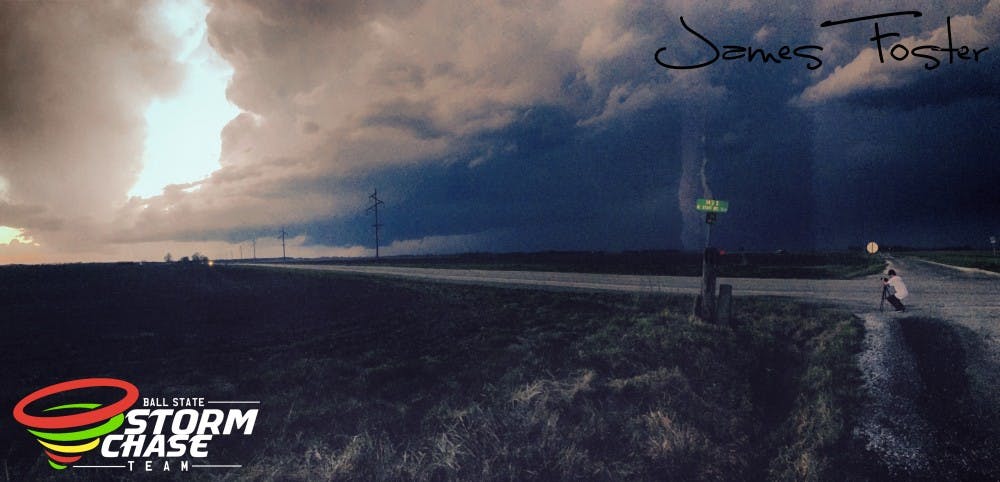Know the difference:
A watch means that a storm or tornado is possible in the area.
A warning means that a storm or tornado has been sighted by spotters or has been indicated on radars.
Take Action:
Stay updated through local news stations
Seek shelter in a sturdy building, away from windows.
Do not wait until you see a tornado to act.
For more information on what to do when there are severe weather conditions, visit redcross.org
The weather may be used to fill an awkward silence for most, but it’s a totally different story for the Ball State Storm Chase Team, a student organization dedicated to observing severe weather in the area in order to provide the community with accurate, real-time information.
Even before his first chase, Adam Grimes, a freshman meteorology major and storm chase team member, had experienced a storm up close.
In grade school an EF-3 tornado hit Grimes' school on his birthday.
"We were celebrating my birthday when the tornado warning was issued," he said. "Then I heard the roar of the tornado, the windows in the hall broke, we heard a large crash. It was over in about 30 seconds, but it was terrifying. Much of the class was crying. I don't remember much after that, but I remember the ride home. I lived about five minutes from school, but it took almost a half hour."
Grimes said the tornado passed 500 feet from his school, breaking windows and throwing a tree into the school, though no one was seriously injured.
Grimes said after that day, he was interested in meteorology. Not all of the members may have a similar experience, but they are all well aware of how serious the weather can get.
Grimes knows just how dangerous severe storms can be. He’s been a trained spotter for five years and has been chasing storms independently for several years. He can still recall his first time out.
“It was exciting, but I was not alone. … I was sitting in the passenger seat with an experienced chaser at the wheel," he said. "It’s important that you get the experience before you go out by yourself so you know all the factors that go into chasing safely.”
Members of the team receive training from the National Weather Service so they can accurately identify weather conditions, and most take Geology 490, a summer class that specializes in the field observation of severe local storms, said the group's director James Foster.
The team goes into the field whenever severe weather is present and meets every other Wednesday to talk about past events and review the basics of storm observations and forecasting, Foster said.
So what does the team look for when they are dealing with severe weather?
Grimes explained a severe storm can have one or more of the following: one-inch diameter hail, wind gusts of 58 miles per hour or more, or the production of a tornado.
He also said while some factors may be obvious, it can be tricky to know just what is happening during field observations.
“We can observe hail and wind; however, when it comes to tornadoes, funnel clouds and wall clouds, … there are several factors to consider when figuring out what exactly you are looking at," he said. "There are several things which can fool you into thinking it’s a tornado, where it may just an area of low-hanging clouds.”
The organization uses special tools to measure certain aspects of storms.
“For hail, we just use rulers, … [but] for wind we use an anemometer to determine speed and even wind direction in some cases,” Grimes said.
The chasers also photograph the storms they observe, getting as close as possible while still staying safe, Foster said.
Though the photos they take are useful to convey what a storm is like, they pale in comparison to the in-person experience, Foster said.
"You have to see the storms and tornadoes in person to capture the awe," he said. "You can see it in pictures, but you have to be there to fathom the size of the storms."
The team stresses the importance of seeking shelter when weather warnings are issued. It is best to stay indoors and away from windows when the conditions takes a turn for the worst.
Although these students deal with serious conditions, they manage to have fun too.
“I love the team and how we help each other out on homework for class, teaching each other new things, and sharing our experiences. Anyone who is interested in weather, I would more than recommend to consider joining the chase team next year,” Grimes said.
Those interested can get information about the Storm Chase Team from the Met Lab on the fourth floor of Cooper Science Complex. The team posts meeting times and locations on its Twitter page as well.





